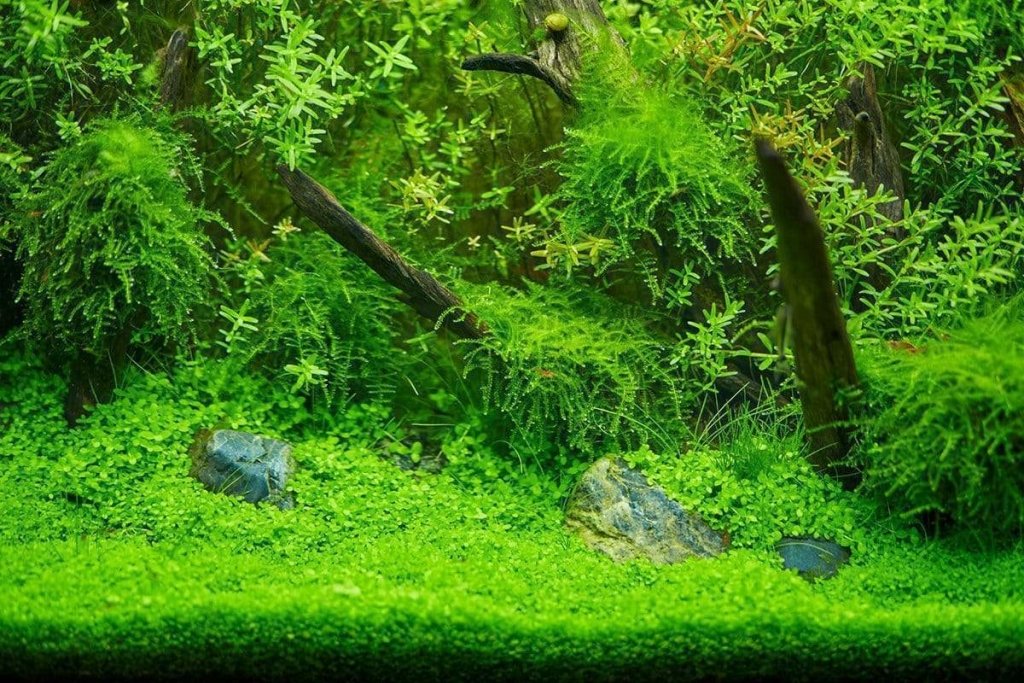If aquarium keeping is your hobby, trying some fun things and creating an eye-catching aquascape should be a part of it. Once you have added enough fish and plants to the tank, bring out the creative side of your personality and add a new look and colors to it through aquascaping.
Apart from growing plants according to their height and adding décor pieces, you can also create a moss wall and make your tank the focal point of the space. This article will give every detail that you will need to make a moss wall and also give some amazing benefits of it.
So, let’s get started!
What is aquarium moss?
Before diving into how to create a moss wall, let’s understand what moss is all about. Moss or aquarium moss are aquatic plants that are grown inside a tank to bring a lush green look to it. There are different types of moss that are grown in aquariums, such as Java moss, Flame moss, Christmas moss, etc. However, for most walls, Java Moss makes one of the best choices.
Moss plants are not only a great decoration species, but they also act as a natural filter for the aquarium’s water. In addition, their dense structure provides ample hiding spots for small fish and shrimps. Therefore, they help in creating a perfect biological balance in the tank.
While you can grow moss like other aquatic plants as well, creating a moss wall makes things more interesting and attractive. Additionally, it can also be used for creating a green carpet look in a tank. All you need is to select the right kind of moss, decontaminate it, and anchor it securely to the driftwood, rock, or mesh inside the aquarium.
When moss gets favorable water conditions and enough nutrients, it proliferates and flourishes. Remember, maintenance is the key to upkeep the moss.
What is Moss Wall?
As the name implies, a moss wall is a wall structure that is created using moss plants. Once you have created the structure, it not only adds attractiveness to the tank but benefits in many other ways.
1. Provides beneficial bacteria- Moss wall helps aquariums provide beneficial bacteria with an excellent breeding ground. In this way, it helps in enhancing the biological filtration capabilities of the tank.
2. Acts as hiding spots– Small, timid, and shy fish often look for spaces in the tank where they can hide, and the moss wall provides them ample of such spots. Additionally, they also act as foraging grounds for food.
3. Acts as water filtration units– There are many aquatic plants that act as natural water filtration units, and moss is one of them. However, you still need to add a filtration device, as the plants only work as a helper in such cases. Relying solely on them will be the wrong choice.
Now that we know what a moss wall is and how it can benefit the aquarium, let’s learn how to make an aquarium moss wall in a step-by-step tutorial.
Creating Aquarium Moss Wall
Step 1: Choosing the right type of moss
First thing first, you need to select the right type of moss that aligns with your imagination of a moss wall. Since there are different types of moss, the next section will help you pick the one according to your growth habit and your choice-
- Java Moss– Those who are new to aquascaping can go for Java Moss without any second thought. The reason behind this is that Java Moss is easy to grow and extremely resilient. It easily attaches to driftwood, rocks, mesh, or any other surface and doesn’t require anything special to grow.
However, not everyone likes the appearance of Java Moss. For them, there are multiple other options as well.
- Willow Moss– This is another very fascinating type of moss that you can use for your moss wall. The leaves of willow moss are broader, and branches are longer than those of Java Moss. Also, it easily attaches to the surfaces and has very little demand for light and nutrition.
- Weeping Moss– Another good option for creating a moss wall is weeping moss. It grows slowly but develops dense foliage that often overhangs. Therefore, it requires a little maintenance over java and willow moss plants. Also, due to its hanging ability, it is often used for creating vertical moss walls.
- Flame moss– The tendency to grow upwards and give an illusion of flames makes flame moss one of the ideal choices for those interested in aquascaping. A glance at flame moss looks like green flames.
- Christmas Moss– Those who love Christmas trees can also create a moss wall with Christmas moss that looks a lot like a typical Christmas tree.
Besides these, there are many more types of moss, like peacock moss, Cameron moss, star moss, Taiwan moss, and more, that can be used to create the moss wall. It will be good to research a little more about the growing pattern, branch, and leaf types of different mosses before picking one for the tank.
Step 2: Cleanse and decontaminate the moss
Once you have selected the right moss, it’s time to make it hygienically fit for your aquarium. It is done by decontaminating the plant by using bleach (5% sodium hypochlorite), hydrogen peroxide (5%), or potassium permanganate. It will ensure that hitchhikers such as algae, snails, harmful bacteria, and other pests won’t enter and infest the water.
The best way to decontaminate is to make a diluted bleach solution by adding 1 part of bleach to 19 parts of water, dip the moss plant, and let it rest in this solution for 1-2 minutes (not more).
The next step is to rinse the plant thoroughly under running water so that bleach does not enter the aquarium. Now, your plant is ready to grow.
Step 3: Selecting the anchors
Moss requires an anchor for support and growth wherever you plant it. Therefore, the next step to create the moss wall is selecting the right anchor. Here, you have to decide what type of wall you wish to create– vertical or horizontal.
While creating the horizontal moss wall is easy, in the case of a vertical moss wall, you would require an anchor that can be tied to the side of your aquarium or leaned against the wall. You can either go for mesh or netting on the sides of the aquarium wall or place flat rocks or pieces of driftwood one above the other. This will create a perfect structure over which moss can anchor and give a moss wall look.
However, using mesh, net, or grid will be the best option as it will allow the moss to spread, grow, and give a perfect illusion of a wall.
Horizontal moss wall is more like carpet, so it won’t require much effort.
Step 4: Attaching moss to anchors
It is the most important step because the moss will grow perfectly only when it is tied to the mesh securely. While you can use different materials for the purpose, aquarists recommend a fishing line as an ideal one.
You may need to adapt different techniques and methods or, rather, hit and trail to ensure that the plants are secured to the anchors. It would usually depend upon the type of moss and anchors you have.
Step 5: Placing anchored moss in the aquarium
The next major step is placing the anchored moss in the right way to create the moss wall look. For this, you must already plan where and how to create the wall– vertically or horizontally.
Usually, it also depends upon the size of your tank, the type of your moss, the anchors that you selected, and the position of your moss wall. Say you are trying to build a vertical moss wall with driftwood as an anchor; you would be required to fix at least 3 to 4 bunches of moss in individual anchors. Next, you have to place them vertically against the aquarium wall. Here, maintaining some space between each is essential, as moss would require room to grow and spread.
In this way, you can create a stunning moss wall in your aquarium and bring more liveliness and uniqueness to your aquascaping. Once everything is set up, maintaining the wall also becomes essential. Below are two important considerations for the upkeep of moss walls. Take a look!
- Fertilizers– Even though mosses are not nutrient suckers, you still need to supply them some for their proper growth. Adding liquid fertilizers will help these plants proliferate. Additional carbon dioxide is not a necessity, but offering it will only help them flourish.
- Sunlight- Mosses love sunlight, and offering them plenty of it will work in your favor. The natural light is required by them for photosynthesis.
- Trimming/Pruning– For creating a beautiful moss wall, you need to trim the plant on a regular basis. Besides, moving things around every now and then to create solid coverage to get the wall look is also necessary.
There is no thumb rule to follow for creating and maintaining a moss wall. It’s an ongoing process where you need to keep performing certain steps to get the exact structure that’s in your mind.
Conclusion
Moss walls could become one of the most fascinating things in your aquarium when created perfectly. It may take time and effort to create it, but when done correctly, the efforts are worth it. No wonder, one day, your moss wall becomes the focal point of your tank instead of your fish and shrimp.
So, try your hands at creating a moss wall after selecting the right moss and anchor. It will not only bring greenery to the aquarium but benefit its ecosystem in multiple ways.





